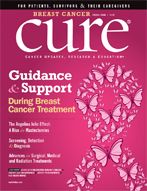Publication
Article
CURE
Mustering the Courage to Decide on Treatment
Author(s):
Choosing a treatment based on data can be fraught with challenges, but it can make all the difference.
Sometimes life takes more courage than you think you can muster. And sometimes life takes more courage than you think you should have to muster. But sometimes you just have to dig down and find it. That was my experience — and now my advice — when faced with making treatment decisions after being diagnosed with breast cancer.
As a professional researcher, used to the world of probabilities and statistics, I wanted to evaluate the data supporting the standard of care the doctors were recommending. That way I could weigh the pros and cons for myself, factor in my own preferences and values, make treatment decisions, and then be responsible for whatever outcome befell me.
But I had no idea how difficult that would prove to be. Not only was that data generally unavailable to the public, I had to defend myself from attacks by several of the doctors I consulted, who were some of the nation’s top practitioners. And I had to do this at a time when I was already stressed by my recent diagnosis, the awareness that my decisions could irrevocably impact the rest of my life, and needing to make decisions quickly while the treatment window was still open.
Whatever decisions I made had to take into account that my tumor was about 2 centimeters and estrogen-receptive, the surgical margins were good, the cancer had spread to the sentinel node but not to others, and the Oncotype DX score was 9 (which meant the risk of my cancer metastasizing was relatively low).
The first oncologist I consulted, head of breast cancer oncology at one of the country’s top cancer hospitals, literally became red in the face with anger at what he considered my insolence in even asking for the data. When pressed, he provided frightening statistics about the consequences of forgoing chemotherapy that I subsequently discovered hadn’t been true for decades.
The second oncologist, head of breast cancer oncology at another top cancer hospital, likened my inquiry to my committing malpractice upon myself and simply refused to provide the data. In his view, “standard of care” trumped any other consideration.
I was finally able to access the relevant research by reading back issues of The New England Journal of Medicine and learned that chemo would probably lower my risk of metastatic cancer 2 to 3 percentage points. This is a reduction deemed statistically significant enough to make chemotherapy the standard of care in my case. But — and here was the critical point — that difference was simply not a big enough difference to me given the potential downsides of chemo: anemia, chemo brain, weakening heart muscles, possible irreversible changes to the way my body felt, including neuropathy, and the general anguish of depression, nausea, hair and weight loss. I was not willing to risk those side effects — and possibly even death — to reduce my risk by those few percentage points.
The third oncologist I consulted, head of breast oncology at yet another top cancer hospital, confirmed that my interpretation of the data was correct, accepted my decision as sound and supported it, although it wouldn’t have been hers initially, and took me on as a patient.
It’s now been six years and I remain cancer-free.
I’m not saying that my decision — or the way I made it — is right for everyone in my situation. But if you are like me and you need information to make your decision, you might just find that you also need some courage, and maybe a lot of courage. I’m living proof that you can do it.
Merle Sprinzen Tessier is a CURE contributor and has been a marketing and business strategist in New York City for more than 30 years.





